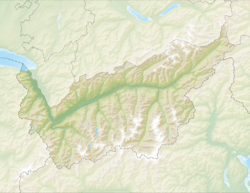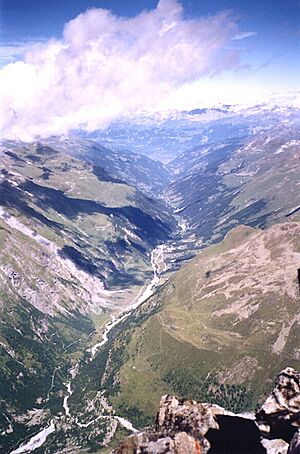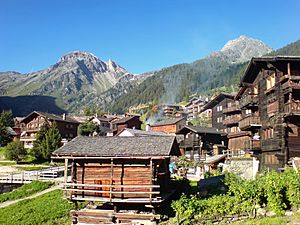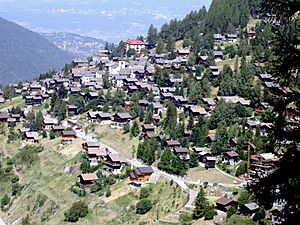Anniviers facts for kids
Quick facts for kids
Anniviers
|
||
|---|---|---|
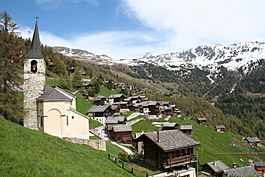
Village of Chandolin in the municipality of Anniviers
|
||
|
||
| Country | Switzerland | |
| Canton | Valais | |
| District | Sierre | |
| Area | ||
| • Total | 243.37 km2 (93.97 sq mi) | |
| Elevation | 1,202 m (3,944 ft) | |
| Population
(Dec 2020 )
|
||
| • Total | 2,742 | |
| • Density | 11.2668/km2 (29.181/sq mi) | |
| Postal code |
3961
|
|
| Localities | Ayer, Chandolin, Grimentz, Saint-Jean, Saint-Luc, Vissoie, Mayoux, Mission, Zinal, Niouc, Fang | |
| Surrounded by | Agarn, Chippis, Oberems, Sierre, | |
Anniviers is a town in Switzerland. It is located in the Valais region, within the Sierre district. Anniviers was formed on January 1, 2009, when six smaller towns in the Val d'Anniviers valley decided to join together. These towns were Ayer, Chandolin, Grimentz, Saint-Jean, Saint-Luc, and Vissoie. This merger made Anniviers the third largest town in Switzerland by land area.
Contents
History
People have lived in the Anniviers region since ancient times. Evidence shows settlements from the Bronze Age and Iron Age. These were periods when people used bronze and then iron to make tools and weapons. Later, Gaulish tribes lived here. The Roman Empire conquered these tribes in the first century. The valley then became part of a Roman province called Helvetia. It was known as Annivesium back then.
Some people believe that the current residents of Anniviers are descendants of the Huns. The Huns were a group of people from Central Asia who moved into Europe a long time ago. There are stories that an old language spoken in the area was similar to Hungarian. People in Val d'Anniviers became Christian later than their neighbors. A writer named Marc-Théodore Bourrit wrote in 1781 that the local bishop struggled to convert the valley's people, who followed an older, pagan religion.
A Hungarian historian, Mihály Horváth, described the people a century later. He noted their light-blue or grayish-green eyes, blonde or brown hair, and strong features. He also mentioned their common nose and broad chin. He said they were generally shorter in height. Other cultural things, like their art, food, and burial customs, also seem to support a link to the Huns.
There are two main ideas about how the people of Anniviers might be connected to the Huns:
- Some believe they are descendants of Attila's followers. These Huns might have settled in the valley after being defeated in a big battle in 451 CE.
- Others think they are descendants of Magyars (Hungarians). The Magyars invaded parts of western Europe in the 10th century.
The valley was called Annivesium until 1052. The Bishop of Sion owned the valley for a while. Later, the Anniviers family and then the Raron family owned it. The bishopric got the property back in 1798.
Some of the towns that make up Anniviers have long histories. Ayer was first mentioned in 1296. Chandolin was mentioned around 1250. Grimentz was first mentioned in 1052. Saint-Jean was first mentioned in 1250. Saint-Luc was first mentioned in 1267, but its full name, Saint-Luc, became official much later, in 1904.
The first simple path for carts was made around 1300. But a proper road for wagons wasn't built until 1854. This road was used to transport nickel and cobalt ores. The paved road we see today was built in 1955. It helped transport materials for building the Dam Moiry. Over time, the number of local churches and separate towns in the valley grew. By 1905, there were six towns: Ayer, Chandolin, Saint-Luc, Saint-Jean, Grimentz, and Vissoie.
Geography
Anniviers covers an area of about 243.1 square kilometers (93.9 square miles). A little over one-fifth of this land (22%) is used for farming. Nearly another fifth (19.4%) is covered by forests. Only a small part (1.5%) has buildings or roads. Most of the land (57.1%) is unproductive, meaning it's not used for farming or building. This often includes mountains and glaciers.
Demographics
Anniviers has a population of about 2,371 people. Around 19.5% of the people living here are from other countries. Over the last ten years (2000–2010), the population grew by 14.4%. This growth was mainly due to people moving into the area.
Most people in Anniviers (89.6%) speak French as their main language. German is the second most common language (3.9%), followed by Portuguese (3.4%).
In 2008, about 52.1% of the population was male, and 47.9% was female. About 25% of the population are children and teenagers (0–19 years old). Adults (20–64 years old) make up 60% of the population. Seniors (over 64 years old) make up 15.1%.
Historic Population
The historical population of the different towns that now form Anniviers is shown in the chart below:
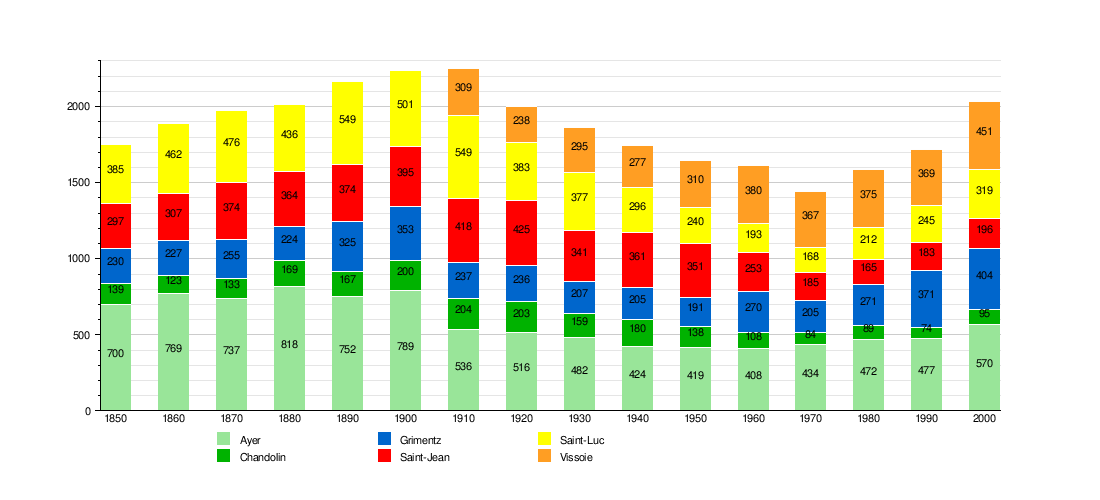
Important Heritage Sites
Some places in Anniviers are very important for their history and culture. For example, the Ilôt Bosquet and Chlasche in Grimentz is a Swiss heritage site of national importance. This means it's a special place protected for its historical value. Also, the villages of Ayer, Grimentz, Saint-Jean, and Vissoie, along with the small village of Pinsec, are all part of the Inventory of Swiss Heritage Sites.
Economy
In 2010, the unemployment rate in Anniviers was 3.5%. This means a small percentage of people looking for jobs couldn't find them.
- About 106 people work in the primary economic sector. This includes jobs like farming, forestry, and mining. There are about 55 businesses in this area.
- About 358 people work in the secondary sector. These jobs involve manufacturing and construction. There are 43 businesses in this sector.
- The tertiary sector employs 669 people. This sector includes jobs in services, like tourism, shops, and offices. There are 142 businesses in this sector.
When it comes to getting to work, 7.5% of the working population uses public transportation. Most people (53.1%) use a private car.
Weather
The village of Grimentz in Anniviers gets rain or snow on about 106.7 days each year. On average, it receives about 769 millimeters (30.3 inches) of precipitation. The wettest month is August, with an average of 82 millimeters (3.2 inches) of rain or snow over about 10.9 days. The driest month is April, with about 52 millimeters (2 inches) of precipitation over 8.6 days.
Education
The town of Vissoie has the Bibliothèque d'Anniviers, which is the local library. In 2008, the library had over 7,000 books and other media. It loaned out more than 5,300 items that year. The library was open for 167 days, usually about 25 hours per week.
Tourism
Anniviers is a popular place for tourists. In the summer, visitors can enjoy many hiking trails and different sports facilities. In winter, there are three main ski areas: Grimentz, Saint-Luc - Chandolin, and Zinal. Another ski area, Vercorin, is also nearby, but it's not officially part of Anniviers.
Special Events
Anniviers is the finish line for two famous races every year: the Sierre-Zinal foot race and the Grand Raid Cristalp mountain bike race.
Regional Specialty
A special wine from the valley is called Vin du Glacier.
Access
- To reach Anniviers, you can use the A9 motorway (Lausanne-Simplon).
- Take the exit for Sierre. From there, it's about 20 kilometers (12 miles) along a scenic mountain road.
See Also
 In Spanish: Anniviers para niños
In Spanish: Anniviers para niños




